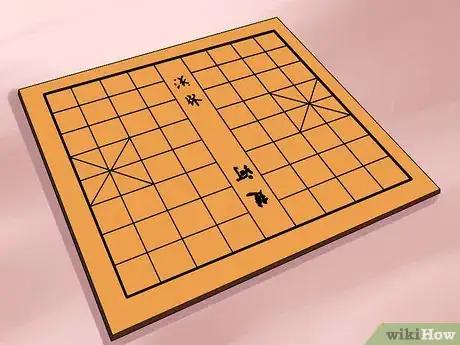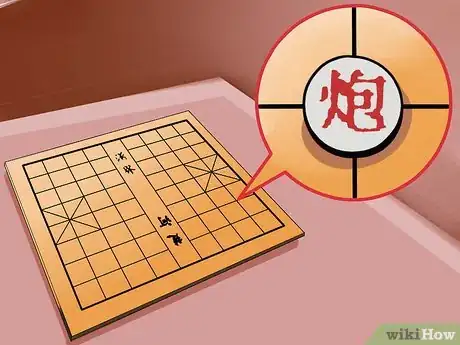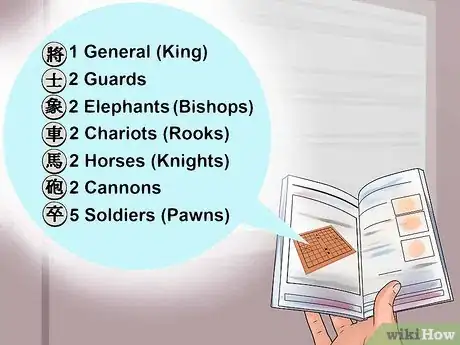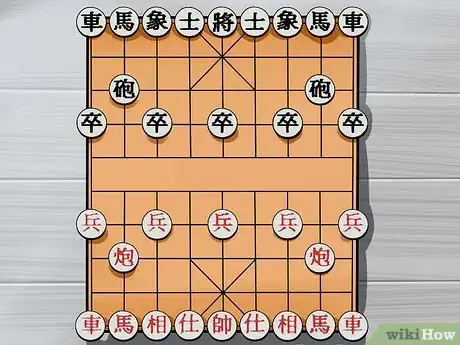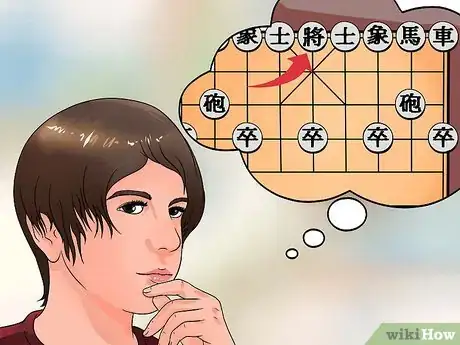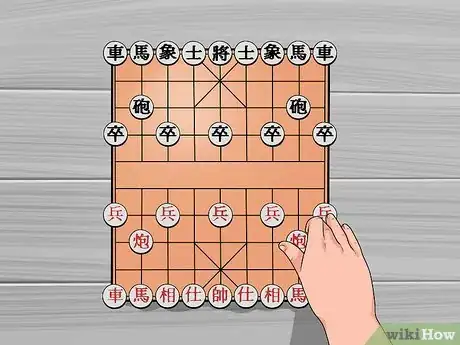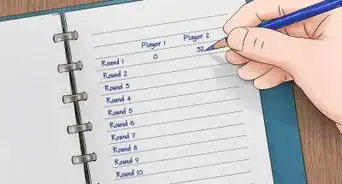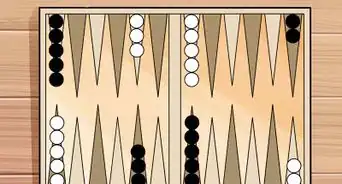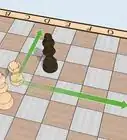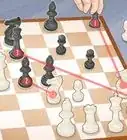This article was co-authored by Sahaj Grover. Sahaj Grover is a Chess Grandmaster, World Champion, and coach, who attained his Grandmaster title at the age of 16. He has been a World Junior Bronze Medalist, World U10 Champion, South African Open 2017 & 2018 Champion, and the Winner of the Arnold Classic 2018 & 2019. Sahaj is known for dynamic attacking skills and being an excellent endgame player.
wikiHow marks an article as reader-approved once it receives enough positive feedback. This article has 12 testimonials from our readers, earning it our reader-approved status.
This article has been viewed 231,598 times.
Chinese chess (象棋, or xiang qi) is a great game for those who love strategy and mastering different endgame methods. Although similar to international Chess, there are different pieces and different rules for moving them. Learn how to play Chinese Chess for a fun and challenging new pastime.
Steps
Getting Ready to Play
-
1Set up the Chinese chess playing board. The board itself has 64 squares, the same number of spaces as an international chessboard. However, the Chinese chess board has a river in the middle that divides the board between opposing players.[1] It also has diagonal lines in some places that designate the boundaries that some pieces may not move beyond.[2]
- No plays can be made in the river. Pieces must cross it to make a play.
- On each side of the playing board, there is an Imperial Palace. The general and guard pieces are not allowed to leave it.
-
2Familiarize yourself with the lines on the board. Chinese chess pieces are placed on line intersections, which are called points, instead of in the actual board squares. The board is made up of 9 by 10 points.[3] On a Chinese chess board, pieces may only move on the line intersections, much like in the game Go.[4]Advertisement
-
3Learn about the Chinese chess pieces. These pieces are quite similar to the pieces in International chess. Each player gets 1 general (king), 2 guards, 2 elephants (bishops), 2 chariots (rooks), 2 horses (knights), 2 cannons, and 5 soldiers (pawns).[5] Each piece is a flat white disk with either red or black markings that make up the Chinese character that corresponds to the piece.[6] Note that red and black have different characters for the general, the guards, the elephants, and the soldiers. [7]
-
4Place your pieces on the board. Each piece has a designated place on the board, as in International chess. To play Chinese chess, you need to make sure that your pieces are all in the correct place on the board. Remember, the pieces go on the intersections, not on the squares.[8]
- On the row nearest you, place your pieces on the points from left to right: the chariot, horse, elephant, guard, king, guard, elephant, knight, and chariot.
- On the third row, place your two cannons on the intersection that is one space from the edge of the right and left side of the board.
- On the fourth row, place your soldier pieces on every other intersection, beginning with the first intersection on the edge of the board.
Playing the Game
-
1Understand the object of the game. As in International chess, your goal is to capture the other player’s general (king).[9] You will need to use your other pieces to put your opponent’s general into checkmate. In the process, you will try to capture as many of your opponent’s pieces as possible to make it easier to put your opponent into checkmate. [10]
-
2Learn the rules that apply to each piece's movement on the board. Each piece in Chinese chess has a specific type of movement that it can make. It is essential to understand these rules for movement in order to play the game. The pieces’ movement rules are as follows:[11]
- The general can move 1 space back or forward, right or left but cannot make a move diagonally. This piece is also not allowed to leave the Imperial Palace area.[12] The general piece may capture any enemy piece which strays into the Imperial Palace area unless that piece is protected by another piece. Generals on the opposite sides of the board cannot be across from each other without another piece between them.
- A chariot or rook piece can move any number of spaces in a straight line horizontally or vertically through the rows of the board.[13]
- The horse piece is equivalent to the knight in international chess rules, in that it can move 1 point any direction and 1 point diagonally (aka 2 points in one direction and 1 point perpendicular to it). However, the horse cannot jump another piece (e.g. If there is a piece in front of the horse blocking its path of 2 points forward).[14]
- Cannon move rules are the same as the chariot/rook with one difference. In order to capture, the cannon has to jump over only 1 piece but it can be of either color.[15]
- Guards can move only 1 point diagonally in either direction but, they cannot leave the Imperial Palace.
- The elephant can move 2 points diagonally, as a bishop can in international chess. However an elephant cannot cross the river on the board.[16] If there is a piece on the point which the elephant has to jump over in order to get to the second point then the elephant can't get to the second point.[17]
- Soldiers can only move and capture 1 point forward (not diagonally) until they cross the river. Once they cross the river, soldiers can move 1 point in any direction except backward.[18] Unlike international chess, a soldier cannot promote if it reaches the end of the board.
-
3Practice Chinese chess rules and learn what each move is called. The player with the red pieces always makes the first move, and then the next player goes. The players alternate turns throughout the entire game. Players may only make one move each per turn. Make sure that you consider the ways each piece is allowed to move before you make your moves.[19]
- To "capture" is to take over the point that the opposing team occupies. It's the same strategic move that's used in international chess.
- You put your opponent's general in "check" if your next move will capture the piece. Your opponent's next move has to be to protect the general from capture.
-
4Win the game by putting your opponent's general in checkmate or by forcing a stalemate. You and your opponent must move and capture each other’s pieces until one of you checkmates the other or neither of you can checkmate the other. In a stalemate situation, the game is considered a draw.[20]
- A "checkmate" occurs when the general cannot escape capture. You can also win if you force your opponent into a "stalemate," in which your opponent cannot make a legal move to protect his general.
- The game is a draw when neither player can force a stalemate or checkmate.
Community Q&A
-
QuestionCan the cannon kill in any number of spaces if it hops over another piece?
 Community AnswerYes, it can. (It can only do that with a piece in front though.)
Community AnswerYes, it can. (It can only do that with a piece in front though.) -
QuestionCan a cannon jump without capturing a piece?
 Community AnswerNo, it cannot.
Community AnswerNo, it cannot. -
QuestionCan I jump in this game?
 Community AnswerThe cannons can jump to take a piece, and the horse can jump as it moves in certain situations (see the diagram above). Other pieces cannot jump.
Community AnswerThe cannons can jump to take a piece, and the horse can jump as it moves in certain situations (see the diagram above). Other pieces cannot jump.
References
- ↑ https://www.britannica.com/sports/Chinese-chess
- ↑ http://ancientchess.com/page/play-xiangqi.htm
- ↑ http://ancientchess.com/page/play-xiangqi.htm
- ↑ https://www.britannica.com/sports/Chinese-chess
- ↑ https://www.britannica.com/sports/Chinese-chess
- ↑ https://en.wikipedia.org/wiki/Xiangqi
- ↑ http://ancientchess.com/page/play-xiangqi.htm
- ↑ http://ancientchess.com/page/play-xiangqi.htm
- ↑ https://www.britannica.com/sports/Chinese-chess
- ↑ http://ancientchess.com/page/play-xiangqi.htm
- ↑ http://ancientchess.com/page/play-xiangqi.htm
- ↑ https://en.wikipedia.org/wiki/Xiangqi
- ↑ https://en.wikipedia.org/wiki/Xiangqi
- ↑ https://en.wikipedia.org/wiki/Xiangqi
- ↑ https://en.wikipedia.org/wiki/Xiangqi
- ↑ https://en.wikipedia.org/wiki/Xiangqi
- ↑ http://www.chessvariants.org/xiangqi.html
- ↑ https://en.wikipedia.org/wiki/Xiangqi
- ↑ http://ancientchess.com/page/play-xiangqi.htm
- ↑ http://www.chessvariants.org/xiangqi.html
About This Article
To play Chinese Chess, you’ll need to use your pieces to put your opponents general into checkmate while capturing as many of their pieces as you can. Like chess, you will need to understand the types of moves each piece can make. For example, a chariot or rook piece can move any number of spaces in a straight line horizontally or vertically. Once you know the moves, set up the board with your opponents pieces on one side and yours on the opposite side. To learn more about moves you can make in Chinese Chess, read on!
